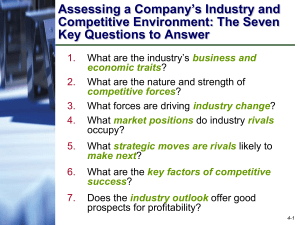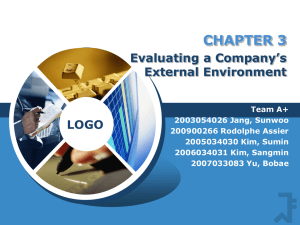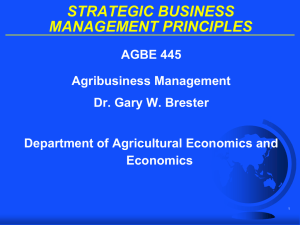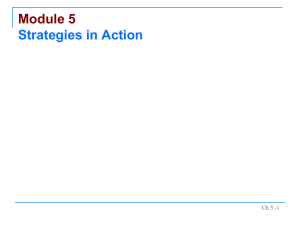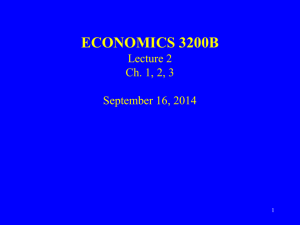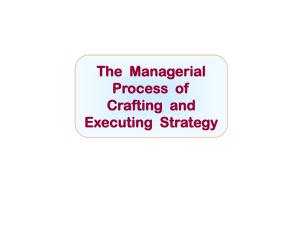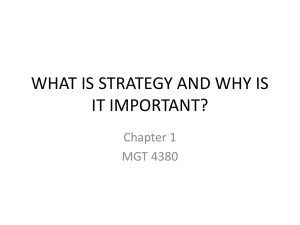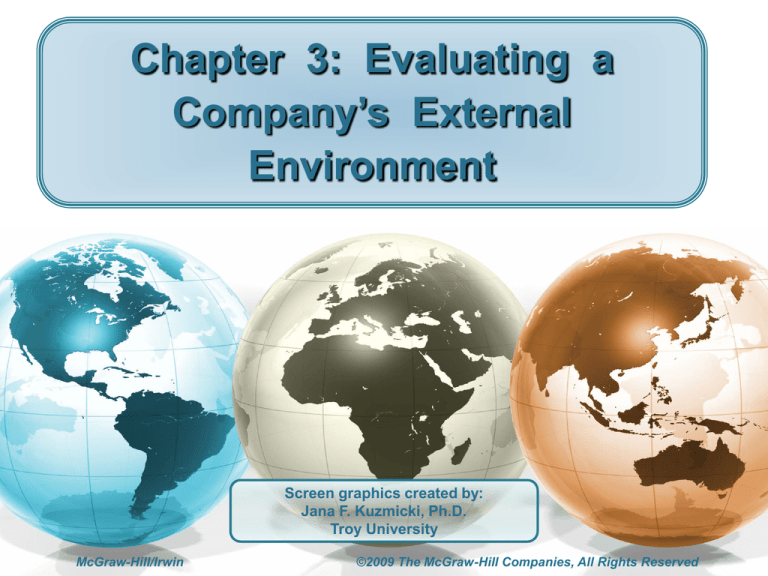
Chapter 3: Evaluating a
Company’s External
Environment
Screen graphics created by:
Jana F. Kuzmicki, Ph.D.
Troy University
McGraw-Hill/Irwin
©2009 The McGraw-Hill Companies, All Rights Reserved
“Analysis is the critical starting
point of
strategic thinking.”
Kenichi Ohmae
Consultant and Author
“Things are always different –
the art is figuring out which
differences matter.”
Laszlo Birinyi
Investments Manager
Chapter Learning Objectives
1. To gain command of the basic concepts and
analytical tools widely used to diagnose a
company’s industry and competitive conditions.
2. To become adept in recognizing the factors that
cause competition in an industry to be fierce, more
or less normal, or relatively weak.
3. To learn how to determine whether an industry’s
outlook presents a company with sufficiently
attractive opportunities for growth and profitability.
4. To understand why in-depth evaluation of specific
industry and competitive conditions is a prerequisite
to crafting a strategy well matched to a company’s
situation.
1-4
Chapter Roadmap
The Strategically Relevant Components of a
Company’s External Environment
Thinking Strategically About a Company’s Industry
and Competitive Environment
Question 1: What Are the Industry’s Dominant Economic
Features?
Question 2: How Strong Are Competitive Forces?
Question 3: What Forces Are Driving Industry Change and
What Impacts Will They Have?
Question 4: What Market Positions Do Rivals Occupy—
Who Is Strongly Positioned and Who Is Not?
Question 5: What Strategic Moves Are Rivals Likely to
Make Next?
Question 6: What Are the Key Factors for Future
Competitive Success?
Question 7: Does the Outlook for the Industry Offer the
Company a Good Opportunity to Earn Attractive Profits?
1-5
Understanding the Factors that
Determine a Company’s Situation
Diagnosing a company’s situation has
two facets
Assessing the company’s external or macroenvironment
Industry and competitive conditions
Forces acting to reshape this environment
Assessing the company’s internal or
micro-environment
Market position and competitiveness
Competencies, capabilities,
resource strengths and
weaknesses, and competitiveness
1-6
Figure 3.1: From Thinking Strategically About the
Company’s Situation to Choosing a Strategy
Figure 3.2: The Components of a Company’s Macro-environment
Thinking Strategically About a
Company’s Macro-environment
A company’s macro-environment includes all
relevant factors and influences outside its
boundaries
Diagnosing a company’s external situation involves
assessing strategically important factors that have a
bearing on the decisions a company’s makes about
its
Direction
Objectives
Strategy
Business model
Requires that company managers scan
the external environment to
Identify potentially important external developments
Assess their impact and influence
Adapt a company’s direction and strategy as needed
1-9
Key Questions Regarding the
Industry and Competitive Environment
What are the
industry’s
dominant
economic traits?
How strong are
competitive
forces?
What market
positions do
rivals occupy?
What moves will
they make next?
What forces
are driving
change in the
industry?
What are the
key factors for
competitive
success?
How attractive
is the industry
from a profit
perspective?
Question 1: What are the Industry’s
Dominant Economic Traits?
Market size and growth rate
Number of rivals
Scope of competitive rivalry
Buyer needs and requirements
Degree of product differentiation
Product innovation
Supply/demand conditions
Pace of technological change
Vertical integration
Economies of scale
Learning and experience curve effects
1-11
Table 3.1: What to Consider in Identifying
an Industry’s Dominant Economic Features
Learning/Experience Effects
Learning/experience effects exist when a
company’s unit costs decline as its
cumulative production volume increases
because of
Accumulating production know-how
Growing mastery of the technology
The bigger the learning or experience
curve effect, the bigger the cost advantage
of the firm with the largest cumulative
production volume
1-13
Question 2: How Strong Are
Competitive Forces?
Objectives are to identify
Main sources of competitive forces
Strength of these forces
Key analytical tool
Five Forces Model
of Competition
1-14
Figure 3.3: The Five Forces Model of Competition
Analyzing the Five Competitive
Forces: How to Do It
Step 1: Identify the specific competitive
pressures associated with each of
the five forces
Step 2: Evaluate the strength of each
competitive force – fierce, strong,
moderate to normal, or weak?
Step 3: Determine whether the collective
strength of the five competitive forces
is conducive to earning attractive
profits
1-16
Competitive Pressures
Among Rival Sellers
Usually the strongest of the five forces
Key factor in determining strength of
rivalry
How aggressively are rivals using various
weapons of competition to improve their
market positions and performance?
Competitive rivalry is a combative
contest involving
Offensive actions
Defensive countermoves
1-17
Figure 3.4: Weapons for Competing and Factors
Affecting Strength of Rivalry
What Are the Typical
Weapons for Competing?
Lower prices
More or different
performance features
Better product
performance
Higher quality
Stronger brand image and
appeal
Wider selection of models
and styles
Bigger/better dealer
network
Low interest rate financing
Better or more ads
Stronger product
innovation capabilities
Better customer service
Stronger capabilities to
provide buyers with
custom-made products
What Causes Rivalry to be Stronger?
Competitors are active in making fresh moves to
improve market standing and business performance
Slow market growth
Number of rivals increases and rivals are ofequal
size and competitive capability
Buyer costs to switch brands are low
Industry conditions tempt rivals to use price cuts or
other competitive weapons to boost volume
A successful strategic move carries a big payoff
Diversity of rivals increases in terms
of visions, objectives, strategies,
resources, and countries of origin
Outsiders acquire weak firms in the
industry and use their resources to transform
new firms into major market contenders
1-20
What Causes Rivalry to be Weaker?
Industry rivals move only infrequently or in a
non-aggressive manner to draw sales from
rivals
Rapid market growth
Products of rivals are strongly
differentiated and customer loyalty is high
Buyer costs to switch brands are high
There are fewer than 5 rivals or there are
numerous rivals so any one firm’s actions
has minimal impact on rivals’ business
1-21
Test Your Knowledge
The rivalry among competing sellers in an industry
intensifies
A. when buyer demand for the product is growing
rapidly.
B. when customers are brand loyal and their costs to
switch to competing brands or substitute products
are relatively high.
C. when buyer demand is strong and sellers have little or
no excess capacity and only minimal inventories.
D. as the number of rivals increases and as they become
more equal in size and competitive capability.
E. when the products of rival sellers are highly
differentiated products and the industry consists of
so many rivals that any one company’s actions have
little direct impact on rivals’ business.
1-22
Competitive Pressures
Associated With Potential Entry
Seriousness of threat depends on
Size of pool of entry candidates
and available resources
Barriers to entry
Reaction of existing firms
Evaluating threat of entry involves assessing
How formidable entry barriers are for each type
of potential entrant and
Attractiveness of growth and profit prospects
1-23
Figure 3.5: Factors Affecting Threat of Entry
Common Barriers to Entry
Sizable economies of scale
Cost and resource disadvantages independent
of size
Brand preferences and customer loyalty
Capital requirements and/or other
specialized resource requirements
Access to distribution channels
Regulatory policies
Tariffs and international trade restrictions
Ability of industry incumbents to launch
vigorous initiatives to block a newcomer’s entry
1-25
When Is the Threat of Entry Stronger?
There’s a sizable pool of entry candidates
Entry barriers are low
Industry growth is rapid and profit
potential is high
Incumbents are unwilling or unable to contest a
newcomer’s entry efforts
When existing industry members have a strong
incentive to expand into new geographic areas
or new product segments where they currently
do not have a market presence
1-26
When Is the Threat of Entry Weaker?
There’s only a small pool of entry candidates
Entry barriers are high
Existing competitors are struggling to earn good
profits
Industry’s outlook is risky
Industry growth is slow or stagnant
Industry members will strongly contest
efforts of new entrants to gain a market foothold
1-27
Competitive Pressures from
Substitute Products
Concept
Substitutes matter when customers
are attracted to the products of
firms in other industries
Examples
Sugar vs. artificial sweeteners
Eyeglasses and contact lens
vs. laser surgery
Newspapers vs. TV vs. Internet
1-28
How to Tell Whether Substitute
Products Are a Strong Force
Whether substitutes are readily
available and attractively priced
Whether buyers view substitutes
as being comparable or better
How much it costs end users
to switch to substitutes
1-29
Figure 3.6: Factors Affecting Competition From Substitute Products
When Is the Competition
From Substitutes Stronger?
There are many good substitutes readily
available
Substitutes are attractively priced
The higher the quality and
performance of substitutes
The lower the end user’s switching costs
End users grow more comfortable with using
substitutes
1-31
When Is the Competition
From Substitutes Weaker?
Good substitutes are not readily available or
do not exist
Substitutes are higher priced relative to
performance they deliver
End users incur high costs
in switching to substitutes
1-32
Competitive Pressures From Suppliers
and Supplier-Seller Collaboration
Whether supplier-seller relationships
represent a weak or strong competitive
force depends on
Whether suppliers can exercise
sufficient bargaining leverage to
influence terms of supply in their favor
Nature and extent of supplier-seller
collaboration in the industry
1-33
Figure 3.7: Factors Affecting Bargaining Power of Suppliers
When Is the Bargaining
Power of Suppliers Stronger?
Industry members incur high
costs in switching their purchases
to alternative suppliers
Needed inputs are in short supply
Supplier provides a differentiated input
that enhances the quality of performance
of sellers’ products or is a valuable
part of sellers’ production process
There are only a few suppliers of a specific
input
Some suppliers threaten to integrate forward
1-35
When Is the Bargaining
Power of Suppliers Weaker?
Item being supplied is a commodity
Seller switching costs to alternative suppliers
are low
Good substitutes exist or new ones emerge
Surge in availability of supplies occurs
Industry members account for a big
fraction of suppliers’ total sales
Industry members threaten
to integrate backward
Seller collaboration with selected suppliers
provides attractive win-win opportunities
1-36
Competitive Pressures: Collaboration
Between Sellers and Suppliers
Industry members often forge strategic
partnerships with select suppliers
to
Reduce inventory and logistics costs
Speed availability of
next-generation components
Enhance quality of parts being supplied
Squeeze out cost savings for both parties
Competitive advantage potential may accrue
to those industry members (sellers) doing the
best job of managing supply-chain relationships
1-37
Competitive Pressures From Buyers
and Seller-Buyer Collaboration
Whether the relationships between industry
members and buyers represent a weak or
strong competitive force depends on
Whether buyers have sufficient
bargaining leverage to influence
terms of sale in their favor
Extent and competitive importance of
strategic partnerships between certain industry
members and the buyers
1-38
Figure 3.8: Factors Affecting Bargaining Power of Buyers
When Is the Bargaining
Power of Buyers Stronger?
Buyer switching costs to competing brands or
substitutes are low
Buyers are large and can demand concessions
Large-volume purchases by buyers are important to
sellers
Buyer demand is weak or declining
Only a few buyers exists
Identity of buyer adds prestige
to seller’s list of customers
Quantity and quality of information
available to buyers improves
Buyers have ability to postpone purchases until later
Buyers threaten to integrate backward
1-40
When Is the Bargaining
Power of Buyers Weaker?
Buyers purchase item infrequently or in small
quantities
Buyer switching costs to
competing brands are high
Surge in buyer demand
creates a “sellers’ market”
Seller’s brand reputation is important to buyer
A specific seller’s product delivers quality
or performance that is very important to buyer
Buyer collaboration with selected sellers
provides attractive win-win opportunities
1-41
Competitive Pressures: Collaboration
Between Sellers and Buyers
Partnerships between industry members
and some/many of their customers can
impact competitive pressures
Collaboration may result in
mutual benefits regarding
Just-in-time deliveries
Order processing
Electronic invoice payments
Data sharing
Competitive advantage may accrue to
those industry members doing the best job
of partnering with their customers
1-42
For Discussion: Your Opinion
Explain why low switching costs and weakly
differentiated products tend to give buyers a
high degree of bargaining power.
1-43
Strategic Implications of
the Five Competitive Forces
Competitive environment is
unattractive from the standpoint
of earning good profits when
Rivalry is vigorous
Entry barriers are low
and entry is likely
Competition from
substitutes is strong
Suppliers and customers have
considerable bargaining power
1-44
Strategic Implications of
the Five Competitive Forces
Competitive environment is ideal from
a profit-making standpoint when
Rivalry is moderate
Entry barriers are high
and no firm is likely to enter
Good substitutes
do not exist
Suppliers and customers are
in a weak bargaining position
1-45
Coping With the
Five Competitive Forces
Objective is to craft a strategy to
Insulate firm from
competitive pressures
Initiate actions to produce
sustainable competitive advantage
Allow firm to be the industry’s “mover and
shaker” with the “most powerful” strategy that
defines the business model for the industry
1-46
Question 3: What Forces Are Driving Industry
Change and What Impacts Will They Have?
Industries change because forces
are driving industry participants
to alter their actions
Driving forces are the
major underlying causes
of changing industry and
competitive conditions
Where do driving forces originate?
Outer ring of macroenvironment
Inner ring of macroenvironment
1-47
Analyzing Driving Forces:
Three Key Steps
STEP 1: Identify forces likely to exert greatest
influence over next 1 - 3 years
Usually no more than 3 - 4 factors
qualify as real drivers of change
STEP 2: Assess impact
Are driving forces acting to cause market
demand for product to increase or decrease?
Are driving forces acting to make competition
more or less intense?
Will driving forces lead to higher or lower
industry profitability?
STEP 3: Determine what strategy changes are
needed to prepare for impacts of driving forces
1-48
Common Types of Driving Forces
Changes in long-term industry growth rate
Increasing globalization of industry
Emerging new Internet capabilities
and applications
Changes in who buys the
product and how they use it
Product innovation
Technological change/process innovation
Marketing innovation
1-49
Common Types of Driving Forces
(con’t)
Entry or exit of major firms
Diffusion of technical knowledge
Changes in cost and efficiency
Consumer preferences shift
from standardized to
differentiated products (or vice versa)
Changes in degree of uncertainty and risk
Regulatory policies / government legislation
Changing societal concerns, attitudes, and
lifestyles
1-50
Table 3.2: The Most Common Driving Forces
Question 4: What Market
Positions Do Rivals Occupy?
One technique to reveal different
competitive positions of industry rivals is
strategic group mapping
A strategic group is a cluster of firms in an
industry with similar competitive
approaches and market positions
1-52
Strategic Group Mapping
Firms in same strategic group
have two or more competitive
characteristics in common
Have comparable product line breadth
Sell in same price/quality range
Emphasize same distribution channels
Use same product attributes to appeal
to similar types of buyers
Use identical technological approaches
Offer buyers similar services
Cover same geographic areas
1-53
Procedure for Constructing
a Strategic Group Map
STEP 1: Identify competitive characteristics that
differentiate firms in an industry from one
another
STEP 2: Plot firms on a two-variable map using
pairs of these differentiating
characteristics
STEP 3: Assign firms that fall in about the same
strategy space to same strategic group
STEP 4: Draw circles around each group, making
circles proportional to size of group’s
respective share of total industry sales
1-54
Example: Strategic Group Map of Selected Automobile Manufacturers
Guidelines: Strategic Group Maps
Variables selected as axes should not be highly
correlated
Variables chosen as axes should expose big
differences in how rivals compete
Variables do not have to be either quantitative
or continuous
Drawing sizes of circles proportional to
combined sales of firms in each strategic group
allows map to reflect relative sizes of each
strategic group
If more than two good competitive variables can
be used, several maps can be drawn
1-56
Interpreting Strategic Group Maps
The closer strategic groups are
on the map, the stronger the cross-group
competitive rivalry tends to be
Not all positions on the map
are equally attractive
Driving forces and competitive pressures often
favor some strategic groups and hurt others
Profit potential of different strategic
groups varies due to strengths and
weaknesses in each group’s market
position
1-57
Test Your Knowledge
A strategic group map is a helpful analytical tool for
A. assessing why competitive pressures and driving forces
usually impact the biggest strategic groups more so than
the smaller groups.
B. determining which companies have how big a competitive
advantage and how good their prospects are for increasing
their market shares.
C. determining which company is the most profitable in the
industry and why it is doing so well.
D. determining who competes most closely with whom;
evaluating whether industry driving forces and competitive
pressures favor some strategic groups and hurt others; and
ascertaining whether the profit potential of different
strategic groups varies due to the strengths and
weaknesses in each group’s respective market positions.
E. pinpointing which of the five competitive forces is the
strongest and which is the weakest.
1-58
Question 5: What Strategic Moves
Are Rivals Likely to Make Next?
A firm’s best strategic moves
are affected by
Current strategies of competitors
Future actions of competitors
Profiling key rivals involves gathering
competitive intelligence about
Current strategies
Most recent actions and public announcements
Resource strengths and weaknesses
Efforts being made to improve their situation
Thinking and leadership styles of top executives
1-59
Competitor Analysis
Sizing up strategies and competitive
strengths and weaknesses of rivals
involves assessing
Which rival has the best strategy? Which
rivals appear to have weak strategies?
Which firms are poised to gain
market share, and which ones
seen destined to lose ground?
Which rivals are likely to rank among the
industry leaders five years from now? Do any
up-and-coming rivals have strategies and the
resources to overtake the current industry
leader?
1-60
Things to Consider in
Predicting Moves of Rivals
Which rivals need to increase their unit sales
and market share? What strategies are rivals
most likely to pursue?
Which rivals have a strong incentive, along with
resources, to make major strategic changes?
Which rivals are good candidates to be
acquired? Which rivals have the resources to
acquire others?
Which rivals are likely to enter new geographic
markets?
Which rivals are likely to expand their product
offerings and enter new product segments?
1-61
For Discussion: Your Opinion
Why does a company need to bother with
studying competitors and trying to predict what
moves rivals will make next? Why can’t it just
choose whatever strategy it wants or make
whatever moves in the marketplace it wishes
without first worrying about what rivals are
going to do?
1-62
Question 6: What Are the Key
Factors for Competitive Success?
Key Success Factors (KSFs) are competitive
factors and attributes that affect every industry
member’s ability to be competitively and financially
successful
KSFs are those particular attributes that are so
important that they spell the difference between
Profit and loss
Competitive success or failure
KSFs can relate to
Specific strategy elements
Product attributes
Resources
Competencies
Competitive capabilities
Market achievements
1-63
Identifying Industry Key Success Factors
The answers to 3 questions often help pinpoint
an industry’s KSFs
On what basis do customers choose
between competing brands of sellers?
What resources and competitive capabilities does a
company need to have to be competitively
successful?
What shortcomings are likely to place a company at
a significant competitive disadvantage?
Rarely are there more than 5 - 6
factors that are truly key to the future financial
and competitive success of industry members
1-64
Table 3.3: Common Types of Industry Key Success Factors
Example: KSFs for Bottled Water Industry
Access to distribution – to get a
company’s brand stocked and
favorably displayed in retail outlets
Image – to induce consumers to
buy a particular company’s product
(brand name and attractiveness of
packaging are key deciding factors)
Low-cost production capabilities –
to keep selling prices competitive
Sufficient sales volume – to achieve
scale economies in marketing expenditures
1-66
Example: KSFs for
Ready-to-Wear Apparel Industry
Appealing designs and color
combinations – to create buyer appeal
Low-cost manufacturing efficiency – to
keep selling prices competitive
Strong network of retailers/company-
owned stores – to allow stores
to keep best-selling items in stock
Clever advertising – to effectively
convey a specific image to induce
consumers to purchase a particular label
1-67
Question 7: Does the Outlook for the
Industry Offer an Attractive Opportunity?
Involves assessing whether the industry and
competitive environment presents a company with
an attractive or unattractive opportunity
for earning good profits
Factors to consider:
Industry growth potential
Whether competitive forces are growing stronger/weaker
Whether driving forces will favorable/unfavorably impact
industry profitability
Degree of risk and uncertainty in industry’s future
Whether the industry confronts severe problems
Firm’s competitive position in industry vis-à-vis rivals
Firm’s potential to capitalize on industry opportunities or
the vulnerabilities of weaker rivals
Whether a firm has sufficient competitive strength to
defend against unattractive industry factors
1-68
Factors to Consider in
Assessing Industry Attractiveness
As a general proposition
If an industry’s overall profit prospects are
above average, the industry environment is
basically attractive
If an industry’s overall profit prospects are
below average, the industry environment is
basically unattractive
However
Attractiveness is relative, not absolute
Conclusions about attractiveness have
to be drawn from the perspective of a
particular company
1-69
Factors to Consider in
Assessing Industry Attractiveness
An industry is unlikely to be equally
attractive or unattractive to all industry
members
Industry environments attractive to strong
competitors may be unattractive to weak competitors
A favorably positioned company may survey an
industry environment and see opportunities that
weak competitors have little or no ability to
capture
Industry environments attractive to insiders may be
unattractive to potential entrants
Under certain circumstances, a firm uniquely wellsituated in an otherwise unattractive industry can
still earn good profits by taking sales and market
share away from weaker competitors
1-70
Core Concept: Assessing
Industry Attractiveness
The degree to which an industry
is attractive or unattractive is not the
same for all industry participants
or potential entrants.
The opportunities an industry
presents depend partly on a
company’s ability to capture them.
Test Your Knowledge
Which of the following is not an important factor for company
managers to consider in drawing conclusions about whether
the industry presents an attractive opportunity?
A. Whether powerful competitive forces are squeezing industry
profitability to subpar levels and whether competition
appears destined to grow stronger or weaker
B. The industry’s growth potential and the degree of
uncertainty and risk in the industry’s future
C. Whether industry profitability will be affected favorably or
unfavorably by the prevailing driving forces
D. How many of the industry’s key success factors do
companies in the industry typically incorporate into their
strategies
E. The company’s ability to capitalize on the vulnerabilities of
weakly positioned rivals and whether the company has
sufficient competitive strength to defend against or
counteract the factors that make the industry unattractive
1-72

